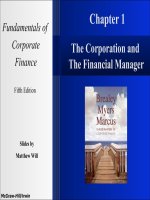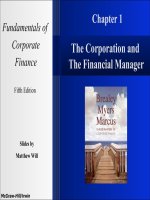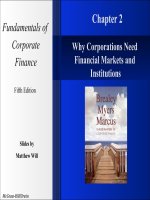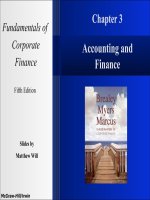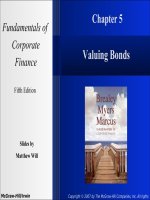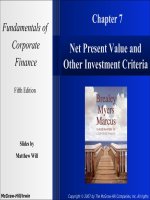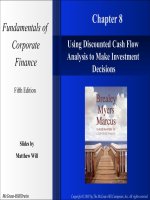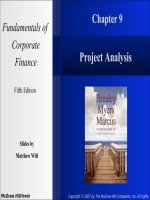Fundamentals of corporate finance 5e mcgraw chapter 012
Bạn đang xem bản rút gọn của tài liệu. Xem và tải ngay bản đầy đủ của tài liệu tại đây (555.83 KB, 28 trang )
Fundamentals of
Corporate
Finance
Chapter 12
The Weighted-Average Cost
of Capital and Company
Valuation
Fifth Edition
Slides by
Matthew Will
McGraw-Hill/Irwin
Copyright © 2007 by The McGraw-Hill Companies, Inc. All rights reserved
12- 2
Topics Covered
Geothermal’s Cost of Capital
Weighted Average Cost of Capital (WACC)
Measuring Capital Structure
Calculating Required Rates of Return
Calculating WACC
Interpreting WACC
Valuing Entire Businesses
McGraw-Hill/Irwin
Copyright © 2007 by The McGraw-Hill Companies, Inc. All rights reserved
12- 3
Cost of Capital
Cost of Capital - The return the firm’s
investors could expect to earn if they
invested in securities with comparable
degrees of risk.
Capital Structure - The firm’s mix of long
term financing and equity financing.
McGraw-Hill/Irwin
Copyright © 2007 by The McGraw-Hill Companies, Inc. All rights reserved
12- 4
Cost of Capital
Example
Geothermal Inc. has
the following
structure. Given that
geothermal pays 8%
for debt and 14% for
equity, what is the
Company Cost of
Capital?
McGraw-Hill/Irwin
Copyright © 2007 by The McGraw-Hill Companies, Inc. All rights reserved
12- 5
Cost of Capital
Example - Geothermal Inc. has the following
structure. Given that geothermal pays 8% for debt
and 14% for equity, what is the Company Cost of
Capital?
Market Value Debt $194
Market Value Equity
Market Value Assets
McGraw-Hill/Irwin
30%
$453 70%
$647 100%
Copyright © 2007 by The McGraw-Hill Companies, Inc. All rights reserved
12- 6
Cost of Capital
Example - Geothermal Inc. has the following
structure. Given that geothermal pays 8% for debt
and 14% for equity, what is the Company Cost of
Capital?
Portfolio Return = (.3x8%) + (.7x14%) = 12.2%
McGraw-Hill/Irwin
Copyright © 2007 by The McGraw-Hill Companies, Inc. All rights reserved
12- 7
Cost of Capital
Example - Geothermal Inc. has the following
structure. Given that geothermal pays 8% for debt
and 14% for equity, what is the Company Cost of
Capital? Portfolio Return = (.3x8%) + (.7x14%) = 12.2%
Interest is tax deductible. Given a 35% tax rate, debt only
costs us 5.2% (i.e. 8 % x .65).
WACC = (.3x5.2%) + (.7x14%) = 11.4%
McGraw-Hill/Irwin
Copyright © 2007 by The McGraw-Hill Companies, Inc. All rights reserved
12- 8
WACC
Weighted Average Cost of Capital (WACC)
- The expected rate of return on a portfolio of
all the firm’s securities.
Company cost of capital = Weighted average of debt
and equity returns.
McGraw-Hill/Irwin
Copyright © 2007 by The McGraw-Hill Companies, Inc. All rights reserved
12- 9
WACC
rassets =
rassets =
total income
value of investments
(D x rdebt ) + (E x requity )
V
rassets = ( x rdebt ) + ( x requity )
D
V
McGraw-Hill/Irwin
E
V
Copyright © 2007 by The McGraw-Hill Companies, Inc. All rights reserved
12- 10
WACC
Taxes are an important consideration in the
company cost of capital because interest payments
are deducted from income before tax is calculated.
After - tax cost of debt = pretax cost x (1 - tax rate)
= rdebt x (1 - Tc)
McGraw-Hill/Irwin
Copyright © 2007 by The McGraw-Hill Companies, Inc. All rights reserved
12- 11
WACC
Weighted -average cost of capital=
WACC =
McGraw-Hill/Irwin
[
D
V
] [
x (1 - Tc)rdebt +
E
V
]
x requity
Copyright © 2007 by The McGraw-Hill Companies, Inc. All rights reserved
12- 12
WACC
Three Steps to Calculating Cost of Capital
1. Calculate the value of each security as a
proportion of the firm’s market value.
2. Determine the required rate of return on
each security.
3. Calculate a weighted average of these
required returns.
McGraw-Hill/Irwin
Copyright © 2007 by The McGraw-Hill Companies, Inc. All rights reserved
12- 13
WACC
Example - Executive Fruit has
issued debt, preferred stock and
common stock. The market
value of these securities are
$4mil, $2mil, and $6mil,
respectively. The required
returns are 6%, 12%, and 18%,
respectively.
Q: Determine the WACC for
Executive Fruit, Inc.
McGraw-Hill/Irwin
Copyright © 2007 by The McGraw-Hill Companies, Inc. All rights reserved
12- 14
WACC
Example - continued
Step 1
Firm Value = 4 + 2 + 6 = $12 mil
Step 2
Required returns are given
Step 3
WACC =
[
4
12
] (
x(1-.35).06 +
2
12
) (
x.12 +
6
12
=.123 or 12.3%
McGraw-Hill/Irwin
)
x.18
Copyright © 2007 by The McGraw-Hill Companies, Inc. All rights reserved
12- 15
WACC
Issues in Using WACC
Debt has two costs. 1)return on debt and 2)increased cost of
equity demanded due to the increase in risk
D
E
B
=
x
B
+
V x Bequity
debt
Betas assets
may changeV with capital
structure
[
] [
]
Corporate taxes complicate the analysis and may change
our decision
McGraw-Hill/Irwin
Copyright © 2007 by The McGraw-Hill Companies, Inc. All rights reserved
12- 16
Measuring Capital Structure
In estimating WACC, do not use the Book
Value of securities.
In estimating WACC, use the Market Value
of the securities.
Book Values often do not represent the true
market value of a firm’s securities.
McGraw-Hill/Irwin
Copyright © 2007 by The McGraw-Hill Companies, Inc. All rights reserved
12- 17
Measuring Capital Structure
Market Value of Bonds - PV of all
coupons and par value discounted at the
current interest rate.
McGraw-Hill/Irwin
Copyright © 2007 by The McGraw-Hill Companies, Inc. All rights reserved
12- 18
Measuring Capital Structure
Market Value of Bonds - PV of all
coupons and par value discounted at the
current interest rate.
Market Value of Equity - Market price per
share multiplied by the number of
outstanding shares.
McGraw-Hill/Irwin
Copyright © 2007 by The McGraw-Hill Companies, Inc. All rights reserved
12- 19
Measuring Capital Structure
Big Oil Book Value Balance Sheet (mil)
Bank Debt
$
200
25.0%
LT Bonds
$
200
25.0%
Common Stock
$
100
12.5%
Retained Earnings $
300
37.5%
Total
$
800
100%
McGraw-Hill/Irwin
Copyright © 2007 by The McGraw-Hill Companies, Inc. All rights reserved
12- 20
Measuring Capital Structure
Big Oil Book Value Balance Sheet (mil)
Bank Debt
$
200
25.0%
LT Bonds
$
200
25.0%
Common Stock
$
100
12.5%
Retained Earnings $
300
37.5%
Total
$
800
100%
If the long term bonds pay an
8% coupon and mature in 12
years, what is their market
value assuming a 9% YTM?
16
16
16
216
PV =
+
+
+ .... +
2
3
12
1.09 1.09 1.09
1.09
= $185.70
McGraw-Hill/Irwin
Copyright © 2007 by The McGraw-Hill Companies, Inc. All rights reserved
12- 21
Measuring Capital Structure
Big Oil MARKET Value Balance Sheet (mil)
Bank Debt (mil)
$ 200.0
12.6%
LT Bonds
$ 185.7
11.7%
Total Debt
$ 385.7
24.3%
Common Stock
$ 1,200.0
75.7%
Total
$ 1,585.7
100.0%
McGraw-Hill/Irwin
Copyright © 2007 by The McGraw-Hill Companies, Inc. All rights reserved
12- 22
Required Rates of Return
Bonds
rd = YTM
Common Stock
re = CAPM
= rf + B(rm - rf )
McGraw-Hill/Irwin
Copyright © 2007 by The McGraw-Hill Companies, Inc. All rights reserved
12- 23
Required Rates of Return
Dividend Discount Model Cost of Equity
Perpetuity Growth Model =
Div1
P0 =
re - g
solve for re
McGraw-Hill/Irwin
Div1
re =
+ g
P0
Copyright © 2007 by The McGraw-Hill Companies, Inc. All rights reserved
12- 24
Required Rates of Return
Expected Return on Preferred Stock
Price of Preferred Stock =
P0 =
Div1
rpreferred
solve for preferred
rpreferred
McGraw-Hill/Irwin
Div1
=
P0
Copyright © 2007 by The McGraw-Hill Companies, Inc. All rights reserved
12- 25
* FCF and PV *
Free Cash Flows (FCF) should be the
theoretical basis for all PV calculations.
FCF is a more accurate measurement of PV
than either Div or EPS.
The market price does not always reflect
the PV of FCF.
When valuing a business for purchase,
always use FCF.
McGraw-Hill/Irwin
Copyright © 2007 by The McGraw-Hill Companies, Inc. All rights reserved
